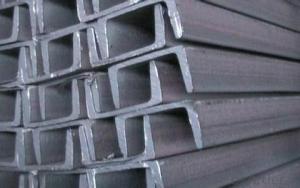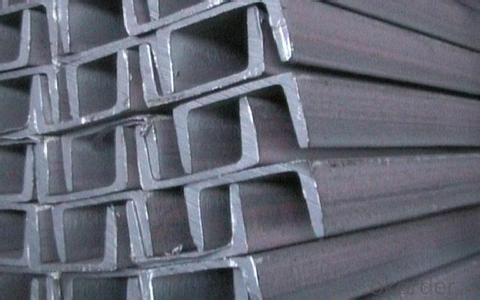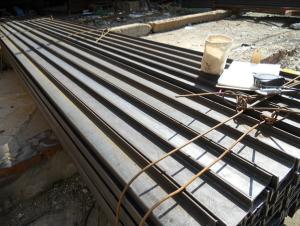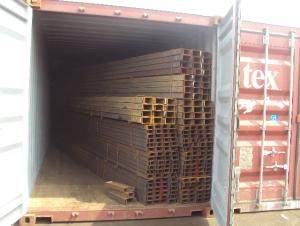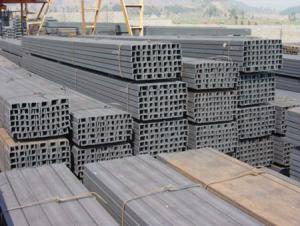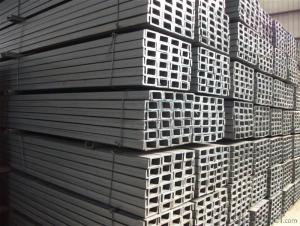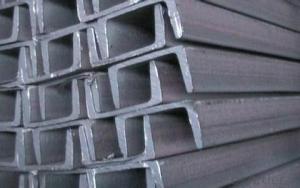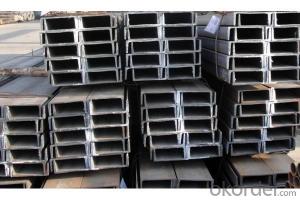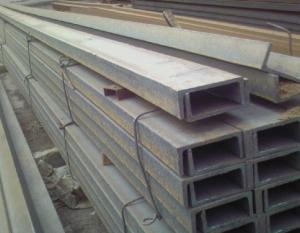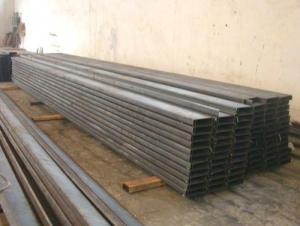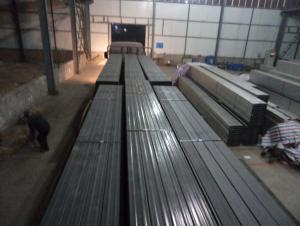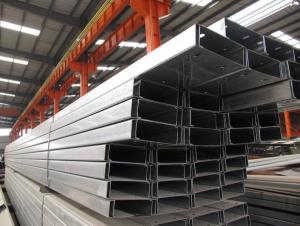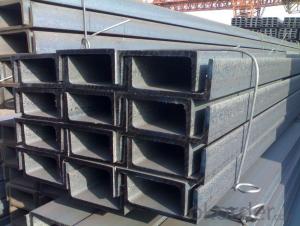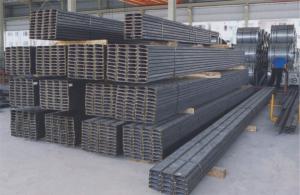steel channel GB;channel beam
- Loading Port:
- Tianjin
- Payment Terms:
- TT OR LC
- Min Order Qty:
- 1000 m.t.
- Supply Capability:
- 3000 m.t./month
OKorder Service Pledge
OKorder Financial Service
You Might Also Like
Product Description:
Specifications of Channel Steel:
| Original Place | Tangshan, China | Brand Name | Bridge |
| Standard | GB707-88, EN100025, JIS G3192, DIN 1026 | ||
| Sizes | 50mm to 300mm | ||
| Sales Volume/Year | 3000MT | ||
| Main Market | Middle East, Africa, Southeast As | ||
1.We are able to provide channel steel of top quality at attractive price.
2.Our products of channel steel have passed ISO9001:2008 Quality Management System Certification.
3. The section of JIS Standard Channel Steel are as followings in the table.
| JIS U CHANNEL | Standard h | Sectional b | Dimension s | t | Mass: Kg/m |
| (mm) | (mm) | (mm) | (mm) | ||
| 50x25 | 50 | 25 | 3.0 | 6.00 | 2.37 |
| 75X40 | 75 | 40 | 3.8 | 7.00 | 5.30 |
| 75X40 | 75 | 40 | 4.0 | 7.00 | 5.60 |
| 75X40 | 75 | 40 | 4.5 | 7.00 | 5.85 |
| 75X40 | 75 | 40 | 5.0 | 7.00 | 6.92 |
| 100X50 | 100 | 50 | 3.8 | 6.00 | 7.30 |
| 100X50 | 100 | 50 | 4.2 | 6.00 | 8.03 |
| 100X50 | 100 | 50 | 4.5 | 7.50 | 8.97 |
| 100X50 | 100 | 50 | 5.0 | 7.50 | 9.36 |
| 125X65 | 125 | 65 | 5.2 | 6.80 | 11.66 |
| 125X65 | 125 | 65 | 5.3 | 6.80 | 12.17 |
| 125X65 | 125 | 65 | 5.5 | 8.00 | 12.91 |
| 125X65 | 125 | 65 | 6.0 | 8.00 | 13.40 |
| 150x75 | 150 | 75 | 5.5 | 7.30 | 14.66 |
| 150x75 | 150 | 75 | 5.7 | 10.00 | 16.71 |
| 150x75 | 150 | 75 | 6.0 | 10.00 | 17.90 |
| 150x75 | 150 | 75 | 6.5 | 10.00 | 18.60 |
4. Chemical Compostion of JIS Standard Channel Steel
| Grade | Element(%) | |||
| C | Mn | P | S | |
| SS330 | -- | -- | ≦0.050 | ≦0.050 |
| SS400 | ||||
| SS490 | ||||
| SS540 | ≦0.30 | ≦1.60 | ≦0.040 | ≦0.040 |
Usage/Applications of Channel Steel:
Channel Steel is usually used for building structure, vehicle manufacturing and other industrial structure and often used with i beam.
In details, the channel steel belongs to carbon structural steel which is applied to in the field of construction and machinery. The channel steel is usually used for arch-itechtural structure, and they could be welded in order to support or hang a vari-ety of facilities. They are also usually used in combination with I beam. Generally,the channel steel must possess perfect welding property, riveting property and mechanical property and so on.
Package & Delivery of Channel Steel:
The steel u channel will be packed in bundle with steel wire at each end of every bundle and color marking in order to help the customer to recognize his goods more easily at sight.
And steel u channel could be loaded into 20ft or 40ft container, or by bulk cargo. If the weight of each bundle reaches less than 3.5 mt, the loading by break bulk cargo should be choosed. When the weight of each bundle reaches less than 3mt, the loading by container should be choosed.
As for the transportaion from mill to loading port, the truck will be usually used. And the maximum quantity for each truck is 40mt.
All in all, we could do in accordance with customer's request.
- Q: What are the different methods for reinforcing steel channels against bending?
- There are several methods for reinforcing steel channels against bending. Some common methods include adding additional steel plates or angles to increase the strength and rigidity of the channel, using stiffeners or braces to provide additional support, and increasing the thickness of the channel itself. Another method is to use composite materials, such as carbon fiber sheets, to enhance the bending resistance of the steel channel. The choice of method depends on the specific requirements and constraints of the application.
- Q: No. 20 I-beam span 3 meters, fixed on both sides, what is the maximum weight to bear? No. 10 channel steel, span 2.5 meters, the other ibid
- No. 20 I-beam span 3 meters, fixed on both sides, five tons is no problem; 10 channel steel, span 2.5 meters, two tons is no problem.
- Q: Are steel channels suitable for railway infrastructure?
- Yes, steel channels are suitable for railway infrastructure. They provide excellent strength and durability, making them ideal for supporting heavy loads and withstanding the wear and tear of train operations. Steel channels also offer flexibility in design and can be easily fabricated to meet specific railway requirements. Additionally, steel's resistance to corrosion and its low maintenance needs make it a cost-effective choice for long-term railway infrastructure projects.
- Q: What are the considerations for steel channel welding?
- When it comes to steel channel welding, there are several considerations that need to be taken into account. First and foremost, it is crucial to ensure that the steel channel is clean and free from any dirt, grease, or rust. This can be achieved by using a wire brush or sandpaper to remove any contaminants before starting the welding process. Failure to properly clean the steel channel can result in weak and faulty welds. Next, the appropriate welding technique and process should be chosen based on the specific requirements of the project. The most common welding processes used for steel channel welding are shielded metal arc welding (SMAW), gas metal arc welding (GMAW), and flux-cored arc welding (FCAW). Each process has its own advantages and limitations, so it is important to select the one that best suits the project's needs. Another important consideration is the choice of welding filler material. The filler material should match the composition of the steel channel to ensure a strong and durable weld. Additionally, the filler material should have good penetration and wetting characteristics to ensure proper fusion between the base metal and the filler material. The welding parameters, such as welding current, voltage, and travel speed, should be carefully adjusted to achieve the desired weld quality. It is important to follow the recommended welding parameters provided by the manufacturer or a qualified welding engineer to prevent overheating or underheating of the steel channel. Furthermore, the use of appropriate welding equipment and safety measures cannot be overlooked. Welding machines, electrodes, and other equipment should be in good working condition to ensure proper and consistent welds. Adequate ventilation and personal protective equipment, such as welding helmets, gloves, and protective clothing, should be used to protect against potential hazards associated with welding, such as fumes, sparks, and UV radiation. Lastly, proper weld inspection and testing should be conducted to verify the quality of the welds. Visual inspection, dye penetrant testing, or radiographic examination can be used to detect any defects or discontinuities in the welds. This step is crucial to ensure the structural integrity and reliability of the steel channel.
- Q: Are steel channels suitable for high-rise construction?
- Yes, steel channels are suitable for high-rise construction. Steel channels are structural components made of steel that have a C-shaped cross-section. They are commonly used in construction due to their strength, durability, and versatility. In high-rise construction, where buildings are subjected to significant vertical and lateral loads, steel channels offer several advantages. Firstly, steel channels have high load-bearing capacity, allowing them to support the weight of the building and withstand the forces imposed on it. This is crucial in high-rise construction, where the structural components need to handle large loads, including the weight of multiple floors, occupants, and equipment. Secondly, steel channels are highly durable and can withstand harsh weather conditions, seismic activities, and other external factors. This is particularly important for high-rise buildings, as they are exposed to more extreme conditions compared to low-rise structures. Steel channels provide the necessary strength and resilience to ensure the structural integrity of the building throughout its lifespan. Additionally, steel channels are versatile and can be easily fabricated, customized, and installed in various configurations to meet the specific requirements of high-rise construction. They can be used as primary structural elements or as secondary components to support other structural members. Their flexibility allows for efficient design and construction, enabling architects and engineers to create tall and complex structures. Furthermore, steel channels offer cost-effectiveness in high-rise construction. Steel is a relatively affordable and readily available material, making it an economical choice for large-scale projects. Additionally, steel channels can be prefabricated off-site, reducing construction time and labor costs. Overall, steel channels are well-suited for high-rise construction due to their strength, durability, versatility, and cost-effectiveness. They provide the necessary structural support and resilience required for tall buildings, making them a reliable choice for this type of construction.
- Q: If there is a cylinder, the diameter is about 1000mm, height is about 1000mm, similar to the kind of pressure vessel, plate thickness 6mm 304 of stainless steel, want to use 4 channel steel leg support, how big is appropriate? How do you calculate it?
- You can only use a few conditions to calculate the weight of the container, do not know what you have in this container, and how much it is loaded. I'm in the container to count on it.The volume of the cylinder is =2 * 3.14 x 500 x 1000 x 6=1.884 * 10^7 (mm3),The volume of the cylinder cover is =2 * 3.14 x 500^2 * 6=9.42 * 10^6 (mm3),
- Q: How do steel channels perform in high-wind areas?
- Steel channels are an excellent choice for structures in high-wind areas due to their strength and durability. Steel is inherently resistant to wind forces and can withstand high winds without significant deformation or failure. The shape of steel channels, which resembles a U or C, also enhances their performance in high winds. The open side of the channel allows wind to pass through, reducing the overall wind load on the structure. This design feature helps minimize the wind-induced pressures, which are particularly important in high-wind areas. Additionally, steel channels are commonly used in conjunction with other structural components, such as beams and columns, to create a robust framework that can withstand the wind's force. These components are often bolted or welded together, providing a strong connection that further enhances the overall performance in high-wind areas. Moreover, steel channels can be fabricated to meet specific project requirements, allowing for customization and optimization of the structural system. This flexibility ensures that steel channels can be engineered and designed to handle the specific wind conditions of a particular location. It is worth noting that the performance of steel channels in high-wind areas also depends on other factors, such as the design of the overall structure, the quality of construction, and adherence to building codes and standards. Proper engineering and construction practices, including appropriate connections and anchoring, are crucial to ensure optimal performance and safety in high-wind areas. In summary, steel channels are highly reliable and effective in high-wind areas due to their inherent strength, shape, and ability to be customized. When properly designed and constructed, steel channels provide a durable and robust solution for structures in regions prone to strong winds.
- Q: Can steel channels be used in oil and gas industry applications?
- Yes, steel channels can be used in oil and gas industry applications. Steel channels are commonly used in the construction of support structures, such as platforms and walkways, in the oil and gas industry. They provide strength and stability to these structures, allowing for safe access and operation in various environments. Additionally, steel channels are also used in the fabrication of piping systems, where they serve as structural components for supporting and aligning pipes. The durability and corrosion resistance of steel make it an ideal material for these applications, as it can withstand the harsh conditions often encountered in the oil and gas industry.
- Q: What are the different load distribution techniques for steel channels in roof systems?
- There are several load distribution techniques that can be used for steel channels in roof systems. These techniques help to ensure that the weight and forces exerted on the channels are evenly distributed, reducing the risk of structural failure. One common load distribution technique is the use of purlins. Purlins are horizontal beams that are placed on top of the steel channels, providing additional support and distributing the load more evenly. These purlins can be made of steel, wood, or other materials, depending on the specific requirements of the roof system. Another technique is the use of bridging. Bridging refers to the installation of vertical or diagonal braces between the steel channels to prevent them from twisting or buckling under heavy loads. This technique helps to distribute the load across multiple channels, increasing their overall strength and stability. Additionally, the spacing of the steel channels themselves can also affect load distribution. Increasing the spacing between channels can help to distribute the load more evenly, as it reduces the concentration of weight on individual channels. However, it is important to ensure that the spacing is within the recommended guidelines to maintain structural integrity. Furthermore, the use of load-bearing walls or columns can also contribute to load distribution in roof systems. By providing additional support at specific points along the channels, these load-bearing elements help to distribute the load and prevent excessive stress on individual channels. In summary, the different load distribution techniques for steel channels in roof systems include the use of purlins, bridging, proper spacing of channels, and the incorporation of load-bearing elements. These techniques work together to ensure that the weight and forces exerted on the channels are evenly distributed, reducing the risk of structural failure and ensuring the long-term durability of the roof system.
- Q: How do steel channels contribute to the stability of a structure?
- Steel channels contribute to the stability of a structure in several ways. Firstly, they provide additional structural support by distributing the load evenly across the structure. The shape of the channel, with its flanges and web, helps to resist bending and twisting forces, preventing any potential collapse or deformation of the structure. Moreover, steel channels enhance the overall strength and rigidity of the structure. The high tensile strength of steel allows for the channels to bear heavy loads without buckling or warping. This added strength and rigidity help to maintain the structural integrity of the building, ensuring its stability during various external forces such as wind, earthquakes, or heavy loads. Steel channels also contribute to the stability of a structure by providing a stable base or foundation. They can be used as beams or columns to support the weight of the structure and transfer the load to the foundation. In this way, steel channels act as a strong and reliable support system, preventing any excessive movement or settlement of the structure. Additionally, steel channels offer versatility in design and construction. They can be easily fabricated into various shapes and sizes to suit the specific needs of the structure. This flexibility allows for efficient and cost-effective construction methods, ensuring stability without compromising on design aesthetics or functionality. In conclusion, steel channels play a vital role in ensuring the stability of a structure. By providing additional support, enhancing strength and rigidity, acting as a stable base, and offering design versatility, steel channels contribute to the overall stability and integrity of a building, making it safe and reliable for its intended purpose.
Send your message to us
steel channel GB;channel beam
- Loading Port:
- Tianjin
- Payment Terms:
- TT OR LC
- Min Order Qty:
- 1000 m.t.
- Supply Capability:
- 3000 m.t./month
OKorder Service Pledge
OKorder Financial Service
Similar products
Hot products
Hot Searches
Related keywords
